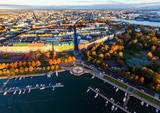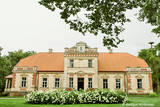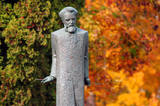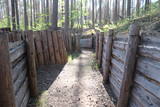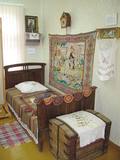| Nr | Name | Beschreibung |
|---|---|---|
|
Im 17. und 18. Jahrhundert besiedelten die Westküste von Peipussee die Altgläubigen, die aus Russland wegen Kirchenreform flüchteten. Die Dörfer der Altgläubigen befinden sich heute kilometerlang am Ufer von Peipussee. Die rund 8 km lange Dorfstrasse (Dõrfer Kasepää, Tiheda, Kükita und Raja) reicht bis zu der Stadt Mustvee und ist heute einer der wenigsten Orten in Estland, wo die Altgläubigen leben. Strassendorf zusammen mit Gebetshäusern und Kulturerbe ist ein attraktives Ausflugsziel und bietet den Gästen stimmungsvolle Erlebnisse. |
||
|
Der Burghügel von Buse (Matkule) befindet sich an einer vom Flüsschen Imula gebildeten Bucht.Vom Hügel zum gegenüberliegenden Ufer der Imula kann man eine der schönsten Ansichten eines kleinen Flusses in Kurzeme genießen. Die beste Sicht hat man natürlich, wenn die Bäume keine Blätter tragen, und die Landschaft nicht von Ufergewächsen verdeckt wird. In der Umgebung gibt es Wanderpfade. |
||
|
Helsinki is the capital of Finland and the biggest city in Finland. It offers a lot to see as it is seaside city surrounded by islands but city itself is full of wonderful parks. This city has everything to attract all kinds of people - from architecture and culture to nature and even has wide range of places where to enjoy night-time Helsinki. |
||
|
Die Bar befindet sich in dem erneuerten Komplex des Landgutes von Smukas (16.Jh.). Im Sommer kann man die Mahlzeit auf der Terrasse des Gästehauses Zirgu stallis, aber im Winter am Kamin in der Bar genießen. Lettische Küche: Vesperbrot der Kurländer (Milchsuppe mit Klößen und einem geräucherten Speck), auf Kohlen gebackener Hering, geschichtetes Roggenbrot-Dessert mit Schlagsahne, ländlicher Milchfladen (Erstmilch, Zucker, Zimt, Gartenbeerensoße), Käsekartoffel mit einem im Honig gebackenen Schweinebraten. |
||
|
Šis ir viens no 6 ceļojuma maršrutiem sērijā "Baudi laukus!", un tas aicina apmeklēt Lauku Labumus – visdažādāko veidu un nozaru saimniecības un uzņēmumus, kas atvērti apmeklētājiem, piedāvā ekskursijas, nogaršot, apskatīt un iegādāties savus ražojumus. Tur apskatāmi mājdzīvnieki, mūsdienīgas lauku saimniecības, amatnieku darbnīcas, iegādājami lauku produkti – maize, medus, mājas vīns un alus, siers, ogas, augļi, zivis, gaļa, dārzeņi, tējas un citi laukos audzēti labumi. Pa ceļam iespējams ieturēt pusdienaslauku krodziņos. |
||
|
Das Haus des Küchenchefs befindet sich im ehemaligen Entbindungsheim "Wilhelma" in Līgatne. Es ist als Ort gedacht, an dem Köche und andere Interessenten etwas unternehmen, kreieren und experimentieren können. Der Autor der Idee ist Küchenchef ikriks Dreibants. Das Ziel dieses Ortes ist es, Sie zu ermutigen, die einzigartigen Geschmäcker und Erlebnisse unserer Region zu erkunden und zu entdecken. Das Haus des Küchenchefs unterstützt die Slow-Food-Philosophie und die umliegenden Bauern und Produzenten. Neben dem Haus gibt es einen Garten für Naturbeobachter, in dem sich ein Spielplatz "Nest im Baum", eine Lupe für einen genaueren Blick auf die Elemente der Natur und ein Picknickplatz mit Kamin befinden. Es gibt einen Kräutergarten im Garten, Obstbäume und Beerensträucher wurden zusammengestellt, aber in der Mitte, neben dem Vogelbeobachtungsplatz, befindet sich eine Schmetterlingswiese. |
||
|
Das Gut Jakiškiai wird in den Quellen ab Ende 16. Jh. genannt. Das Gutshaus hat Züge des Klassizismus. Von den einstigen Gebäuden des Ensembles sind das Herrenhaus, der Eiskeller und die Dampfmühle erhalten. Das Gut wurde nicht restauriert und ist daher immer noch authentisch anzusehen – der künstlerische Geist hat einiges an Hausrat vor der Vernichtung bewahrt: Gegenstände aus der Zeit der Gutsherren Koschkull und aus der Sowjetzeit. Neben den Gutsgebäuden sind einige Fragmente des (einst 2 ha großen) Parks erhalten: die Lindenallee an der Einfahrt, wertvolle alte Lärchen, Pappeln, Kiefern und ein kleiner Teich. |
||
|
Liela meža masīva vidū gleznainās Būkas (Būka) upes krastos starp kokiem ieslēpies teiksmainais Vaišnoriškes ciems. Šis ir viens no skaistākajiem nacionālā parka etnogrāfiskajiem ciemiem. Vaišnoriške kā apdzīvota vieta sākusi veidoties 1756. g., kad šeit sena vēsturiska ceļa malā darbojies krogs. Pirmā viensēta ciematā ir zināma no 1830. g. Šodien redzamā apbūve ir tapusi g.k. 20. gs. sākumā. Ciems ir palicis cilvēku atmiņās ar liepu medu, jo meža velšu vākšana un biškopība bija viena no galvenajām šejieniešu nodarbēm. Tagad ciemā ir piecas sētas. No Vaišnoriškes var uzsākt laivu braucienu pa seklo un dzidro Būku. |
||
|
The craftsman uses experimental archaeological methods to produce the jewellery of ancient Baltic tribes. He will tell you about their symbolism, meaning and wearing traditions. You can tour the workshop and purchase jewellery that has been made there. |
||
|
In Limbaži, an der Kreuzung der Straßen Cēsu und Dailes befindet sich ein Denkmal für den Autor der Nationalhymne Lettlands. Die Autoren des Denkmals sind die Bildhauer Z. Rapa und J. Rapa. Das Denkmal wurde am 16. Mai 1998 eröffnet, zum 775-Jubiläum der Stadt Limbaži. |
||
|
The owner of the guesthouse produces homemade wine from blackberries, black currants, lingonberries, oak leaves, birch sap, strawberries, gooseberries, apples, cranberries, cowslip, and 20 other raw materials. You can taste the wines, learn about how it is produced, and purchase some to take along with you. |
||
|
Iekārtots bijušā Džūkstes – Lancenieku skolā, kur ikviens var iepazīt mūsu „Pasaku tēva” – Anša Lerha-Puškaita devumu folkloras mantojuma vākšanā.
|
||
|
Ar Kara muzeja informatīvo atbalstu Garā kāpā pie Antiņiem ir rekonstruēta daļa latviešu strēlnieku nocietinājumu sistēmas. Aspkatāmas ierakumu pozīcijas un vairākas zemnīcas. Netālu atrodas bijusī un no dzelzsbetona veidotā medikamentu glabātuve. |
||
|
Befindet sich im südöstlichen Teil von Piedruja am Daugava -Ufer. Zum Stein führt den Piedruja-Pfad und einen örtlichen Landweg. Der Autor des Gedenksteins ist der Bildhauer Vilnis Titāns. Auf dem Stein ist das Wort Daugava in sieben Sprachen angebracht: auf Lettisch, Livisch, Estnisch, Polnisch, Russisch, Deutsch und Finnisch. Vom Stein ist sehr gut die weißrussische Stadt Druja am gegenüberliegenden Daugava-Ufer und eine große Insel zu sehen, die den Fluss in zwei Teile teilt. Vor der Reise nach Piedruja muss man die Aufenthaltserlaubnis fürs Grenzgebiet erhalten. |
||
|
The History Museum of Malta. Exposition „History of Malta parish: from
Rozentova and Borovaja to Malta”. We offer household items, tools of trade,
works of art, collection of paper money and coins. Excursion outside the museum
„At the cross-roads of Malta”.
Working hours: Mon– Fri : 9.00 – 17.00, Sat., Sunday : closed |
||
|
Der Bauernhof und die Molkerei Mätiku betreibt Milchproduktion und -verarbeitung und züchtet auch Legehennen und Schafen. In der kleinen Molkerei werden verschiedene Milchprodukte aus der Milch von eigenen Kühen produziert. Nach vorheriger Anmeldung kann man den Bauernhof besichtigen, sich mit seiner Arbeit vertraut machen und die Produkte verkosten. |
||
|
This is the second thickest tree in Latvia and the Baltic States. There is a large and open hole in the trunk of the tree. Like most trees of its size, it has suffered lightning damage. The tree is a wonderful part of the landscape, and a little wooden fence has been put up around it.
|
||
|
1,7 km gara lokveida taka, kas iepazīstina ar dažādiem meža biotopiem, to iemītniekiem un meža apsaimniekošanas pamatprincipiem. Apmeklētāju ērtības nolūkā ir izveidotas koka laipas un neliels skatu tornis. |
||
|
Die Bauernwirtschaft Iesalnieki-1 befindet sich in der Gemeinde Vietalva der Region Pļaviņas. Der Hauptbereich der Wirtschaft ist Getreidezucht – Raps, Gerste, Weizen und Gräser. Gesamtfläche 180 ha. Interessant ist die Tatsache, dass zwei Brüder mit eigenen Kräften zusammen mehr als 800 ha bewirtschaften. |
||
|
Das alte zemgalicshe wirtschaftspolitische Zentrum, das eine stark befestigte Siedlung vor der Ankunft der Kreuzritter war. Die Ruinen der Burg des Livländischen Ordens. |
||



